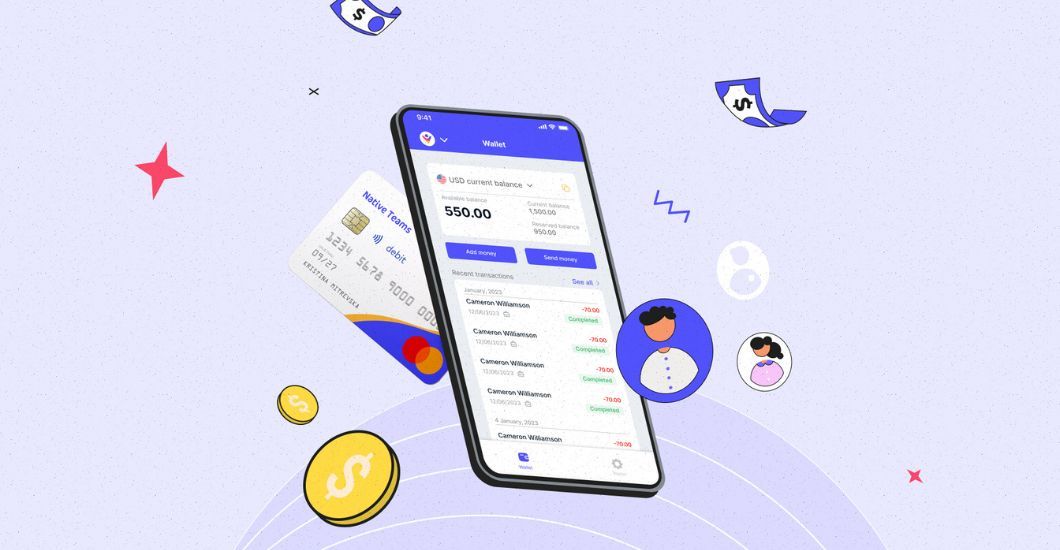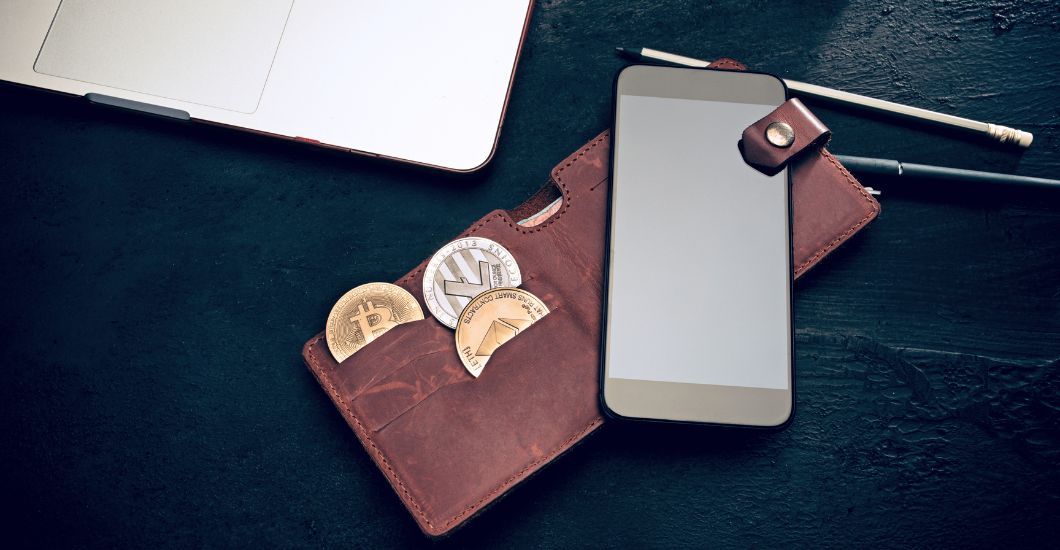How Does a Digital Wallet Work: Is it Safe in 2025?
In a world where digital transactions rule our everyday lives, understanding the essence of a Digital Wallet might be crucial. Let’s learn how they operate, their types, advantages, and safety features in our in-depth guide, perfect for beginners and tech enthusiasts alike!

What is a digital wallet?
A digital wallet, sometimes referred to as an e-wallet or a mobile wallet, is a software application, web service, or electronic device that enables parties to exchange digital currency units for products and services. It serves as a virtual version of a physical wallet, allowing users to make electronic payments and conduct financial transactions without the need for physical cash or traditional payment methods.
Digital wallets can be used for a variety of purposes, including:
- Online Purchases: Users can store their payment information in a digital wallet and use it to make online purchases on e-commerce websites.
- Mobile Payments: Many digital wallets are integrated with mobile devices, enabling users to make in-store payments using their smartphones or other mobile devices. This is often facilitated through technologies like Near Field Communication (NFC) or QR codes.
- Peer-to-Peer Transactions: Some digital wallets allow users to send money to friends or family members directly, often through a linked bank account or credit card.
- Contactless Payments: Digital wallets can support contactless payment methods, allowing users to make quick and secure transactions by tapping their devices on compatible payment terminals.
- Ticketing and Loyalty Programs: Some digital wallets also support the storage of digital tickets, boarding passes, and loyalty program information.
Evolution of digital wallets over time
The first reported digital payment system was the beginning of the first e-wallet, which was created as early as 1997. Coca-Cola developed a payment system that allowed customers to purchase soft drinks using their smartphones and complete transactions via text message. Even if the methods and solutions used today function on several levels, including online and point-of-sale, this event catalysed the development of the current e-wallet.
How do digital wallets work?
Digital wallets, also known as mobile wallets, function as virtual containers that securely store payment information, such as credit or debit card details, bank account information, or cryptocurrency. To utilise a digital wallet, users download a dedicated app, linking it to their funding sources during setup. This involves inputting information and, in some cases, verifying identity through security measures. Once set up, the digital wallet securely stores this payment information, encrypting it for protection.
Digital wallets have a simple working mechanism, which can be explained as follows: When you make a payment, the digital wallet creates a one-time-use token consisting of random digits rather than providing the retailer with your actual credit or debit card number. Your personal information is kept private while the payment is processed using that token. The digital wallet system works through NFC (Near Field Communication), QR codes and MST (Magnetic Secure Transmission.)
- NFC technology uses electromagnetic signals to link and transfer data between two smart devices. For a connection to occur, two devices must be near one another.
- QR codes store your wallet information as matrix bars. To make your payment, there should be a digital scanner, a camera and a phone to use as a digital wallet.
- MST is the technology that allows magnetic card readers to read cards that slide through slots at points of sale. This encrypted field, which the point of sale can read, is generated by your phone.
Steps to set up and use a digital wallet
Setting up and using a digital wallet involves several steps. The specific process may vary depending on the type of digital wallet you choose (e.g., mobile wallet, desktop wallet, online wallet). Here are general steps to help you get started:
- Research and choose a digital wallet:
- There are various types of digital wallets, including mobile wallets (e.g., Apple Pay, Google Pay), desktop wallets (e.g., Exodus, Electrum), and online wallets. Choose the one that best suits your needs.
- Download and install the wallet app:
- If you’re using a mobile wallet, go to the App Store (iOS) or Google Play Store (Android) and download the app. For desktop wallets, visit the official website of the wallet provider and download the software.
- Create an account:
- Open the wallet app and create an account. This usually involves providing a valid email address, creating a secure password, and sometimes completing a verification process.
- Secure your wallet:
- Set up additional security measures, such as two-factor authentication (2FA) or biometric authentication (fingerprint, face recognition) if available. Consider using a strong, unique password.
- Back-up your wallet:
- Many wallets provide a recovery seed or backup phrase. Make sure to write down and securely store this information. This seed allows you to recover your wallet if you forget your password or lose access.
- Add funds to your wallet:
- Depending on the type of wallet, you may need to link a bank account, credit card, or deposit cryptocurrency into your wallet. Follow the instructions provided by the wallet provider for adding funds.
- Use your digital wallet:
- Once your wallet is funded, you can use it for various purposes, such as making online purchases, sending/receiving money, or storing cryptocurrencies. Follow the specific instructions within the wallet app for the actions you want to perform.
Remember that different wallets may have specific features and nuances, so it’s crucial to familiarise yourself with the specific instructions provided by the wallet provider you choose.
Related Article: Latest Payment Trends Transforming the Industry – Native Teams

Types of digital wallets
I. Closed Wallets: Closed wallets are digital wallets that are issued by a specific company or organisation and are limited to transactions within that company’s ecosystem.
Example:
-Starbucks Mobile App: The Starbucks app allows users to make purchases and earn rewards within the Starbucks ecosystem.
II. Semi-Closed Wallets: Semi-closed wallets are digital wallets that enable transactions within a specific network of merchants or service providers. While they may allow external fund transfers, their primary use is often within the designated network.
Examples:
-Google Pay: Although Google Pay allows peer-to-peer transactions, it is particularly designed for in-app and in-store payments, promoting transactions within its partner network.
– Samsung Pay: Similar to Google Pay, Samsung Pay focuses on in-store and in-app purchases within its supported network.
III. Open Wallets: Open wallets are versatile digital wallets that facilitate transactions both within and outside a predefined network. Users can make purchases, transfer funds, and engage in various financial activities with a broader range of merchants.
Examples:
– Apple Pay: Apple Pay is an open wallet that supports in-store, in-app, and online transactions. Users can also link their Apple Pay account to various banks and financial institutions.
– PayPal: PayPal is a widely used open wallet that allows users to make online transactions, transfer money to friends and family, and link to various financial accounts.
Popular digital wallets
A. Google Pay: Google Pay is a digital wallet platform developed by Google. It supports both online and in-store contactless payments.
Key Features:
- Contactless payments in stores.
- Peer-to-peer transactions.
- Integration with loyalty programs and offers.
B. Apple Pay: Apple Pay is a mobile payment and digital wallet service offered by Apple Inc. It is compatible with iPhones, Apple Watches, iPads, and Macs.
Key Features:
- In-store, in-app, and online payments.
- Secure transactions with Face ID or Touch ID.
- Integration with credit and debit cards.
C. Samsung Pay: Samsung Pay is a mobile payment and digital wallet service provided by Samsung. It is compatible with Samsung Galaxy smartphones and smartwatches.
Key Features:
- Magnetic Secure Transmission (MST) for compatibility with traditional card readers.
- In-store, in-app, and online payments.
- Integration with loyalty programs.
Advantages of using a digital wallet
Using a digital wallet offers several advantages, making financial transactions more convenient, swift, and secure. One key benefit is the speed of transactions – digital wallets enable quick and seamless payments, reducing the need for physical cash or card swipes. Enhanced security features, such as biometric authentication and tokenisation, provide a robust layer of protection against fraud and unauthorised access.
Additionally, digital wallets often come with organisational tools, allowing users to track expenses and manage receipts effortlessly. The rise of contactless payments is another notable advantage, promoting an efficient way to make purchases, especially in environments where speed and minimal physical contact are essential. Overall, digital wallets streamline the payment process while offering a range of features that contribute to a more efficient and secure financial experience.
Potential drawbacks
While digital wallets offer notable advantages, users should be mindful of potential drawbacks. One limitation is the varying acceptance of digital wallet payments among merchants, which can lead to instances where users may need alternative payment methods. Additionally, the reliance on technology introduces security concerns, including the risk of data breaches and phishing scams targeting sensitive financial information.
For some individuals, especially those facing technological barriers or residing in areas with limited connectivity, adopting digital wallets may pose challenges, affecting their accessibility and overall utility. Balancing these drawbacks with the benefits is crucial for users considering the integration of digital wallets into their financial routines.
Digital wallets vs Traditional payment methods
The comparison between digital wallets and traditional payment methods highlights distinct differences in convenience, security, and accessibility. Digital wallets offer unparalleled convenience with quick and seamless transactions, reducing the reliance on physical cards or cash. Enhanced security features, such as biometric authentication and tokenisation, contribute to a more secure financial experience.
In contrast, traditional payment methods, like credit and debit cards or cash, may lack the advanced security layers provided by digital wallets. However, traditional methods maintain widespread acceptance, catering to individuals who may face technological barriers or prefer the familiarity of established payment systems. The choice between digital wallets and traditional methods often depends on individual preferences, technological comfort, and the level of acceptance within the user’s ecosystem.

Future of digital wallets
The future of digital wallets is assured for dynamic evolution, driven by technological advancements and changing consumer behaviours. One notable trend is the continued integration of contactless payment methods, spurred by a growing emphasis on hygiene and convenience. The rise of decentralised finance (DeFi) and blockchain technologies is likely to impact digital wallets, offering users greater control over their financial assets and promoting increased security.
As artificial intelligence (AI) continues to advance, digital wallets may incorporate more personalised and predictive features, enhancing user experiences. Additionally, the integration of digital currencies, including central bank digital currencies (CBDCs) and cryptocurrencies, is expected to play a significant role in reshaping the landscape of digital payments.
Overall, the future of digital wallets promises a convergence of innovative technologies, increased security measures, and a more diverse range of financial instruments, shaping the way individuals manage and transact in the digital economy.
Summing up, digital wallets have been a part of modern lives for the last 2 decades. With various types and many advantages, such as swiftness, hygiene, and adaptability to technological advancements, they are likely to continue to shape the future of payments and transactions.
